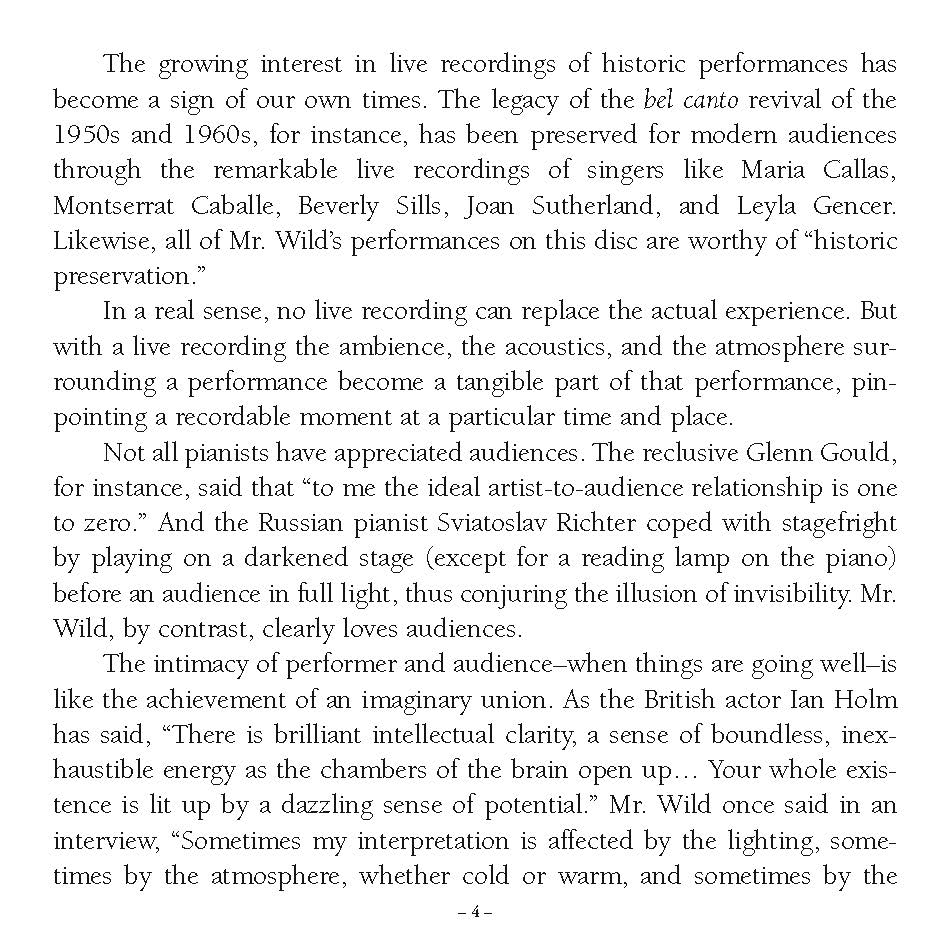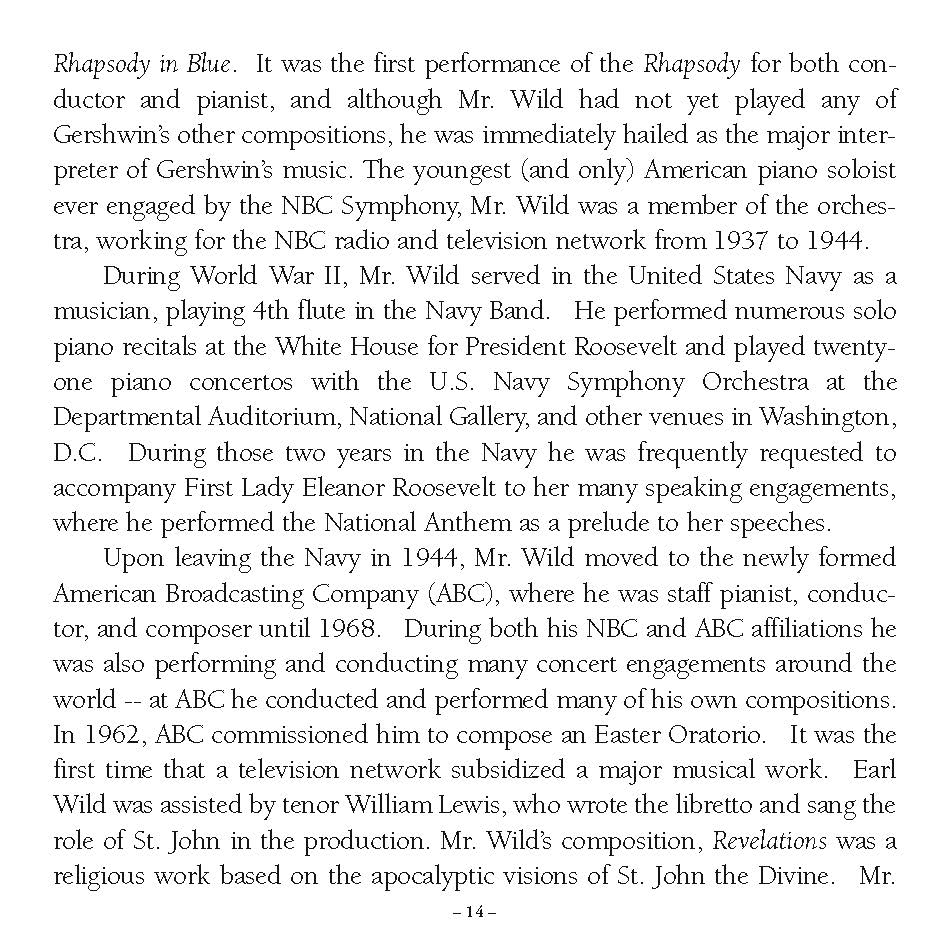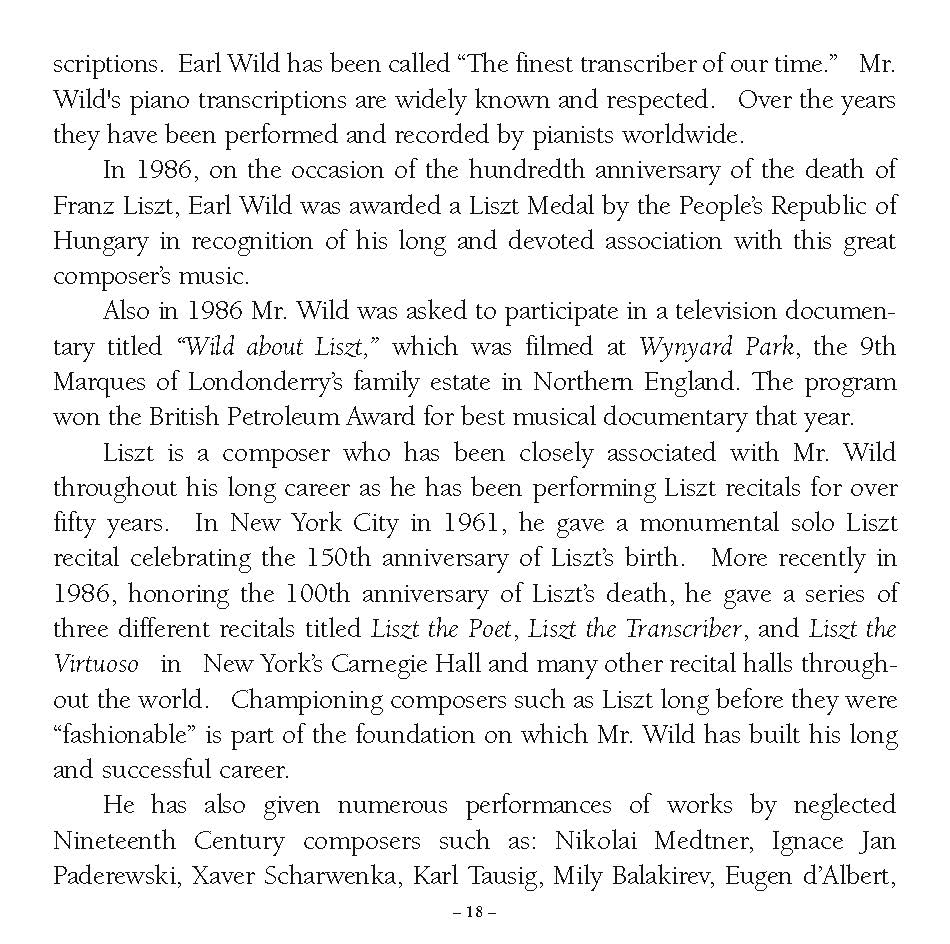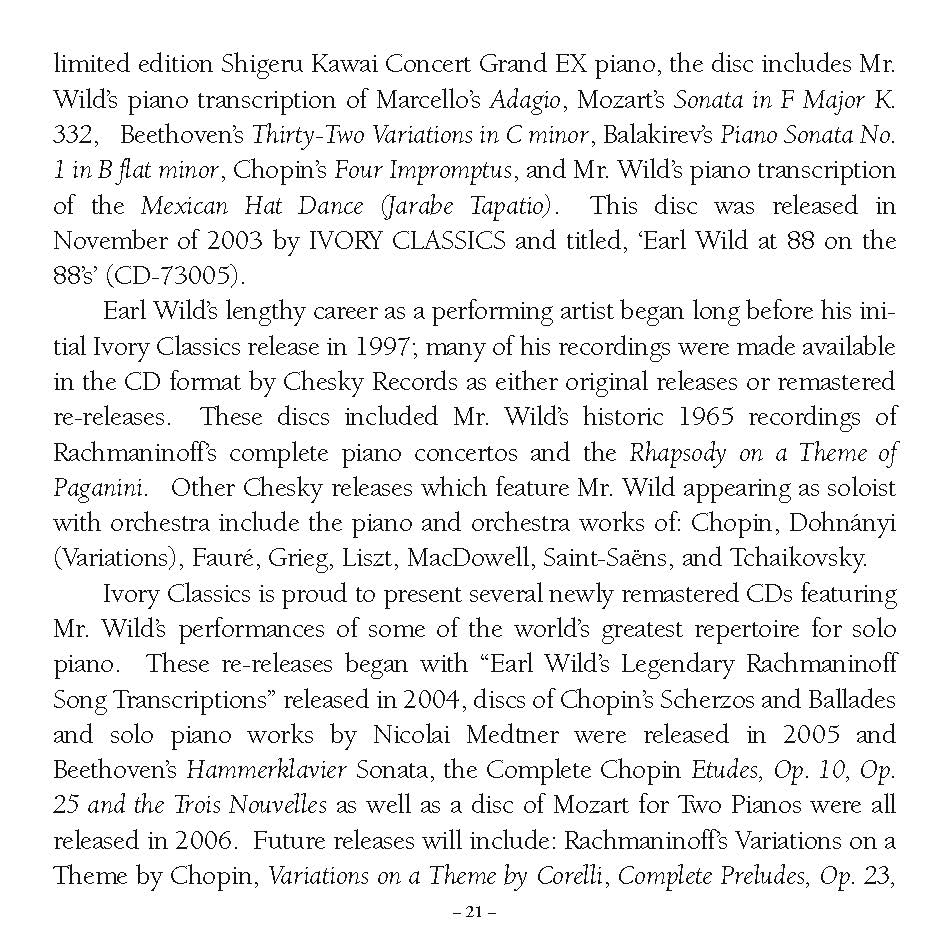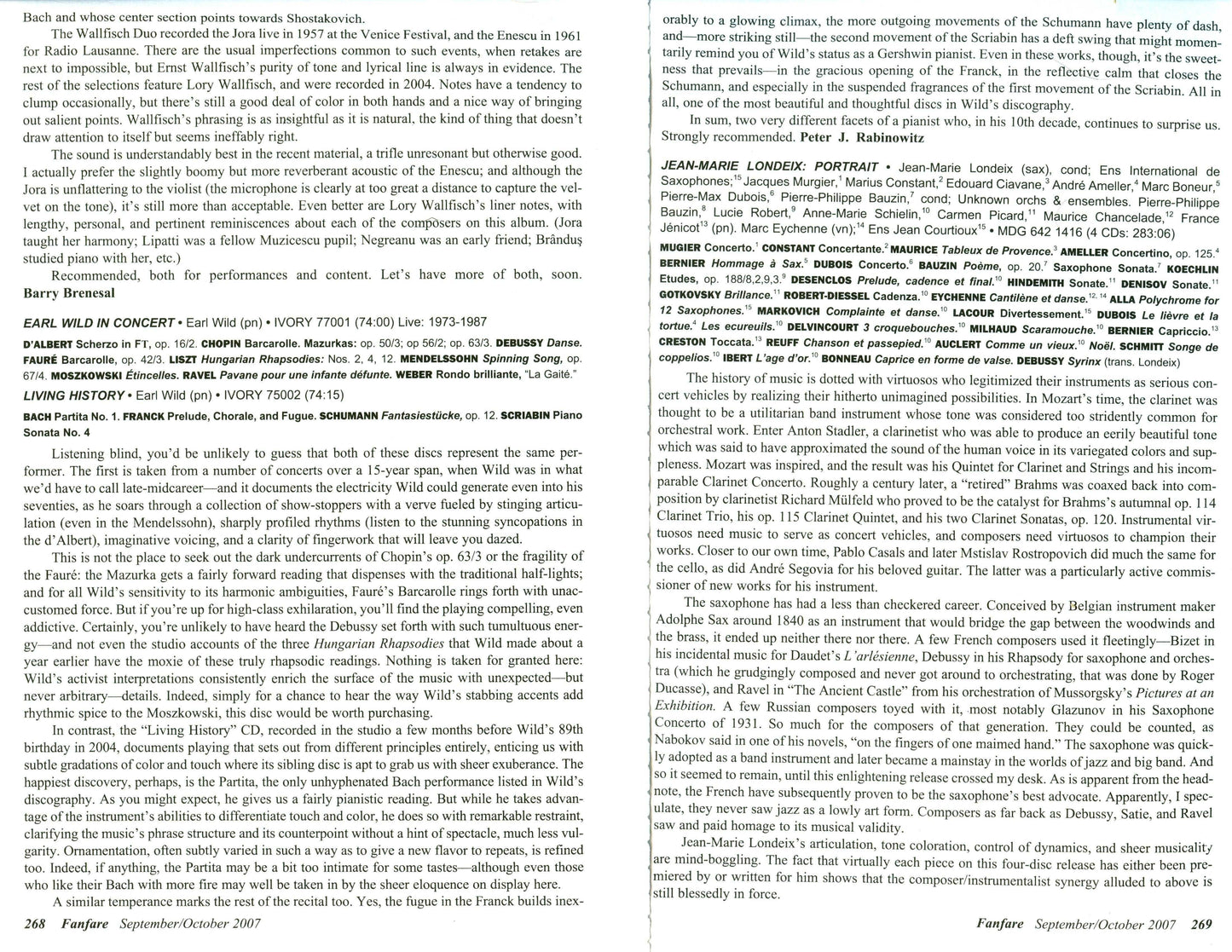1
/
of
26
Earl Wild: In Concert (1973-1987)
Earl Wild: In Concert (1973-1987)
Regular price
$10.00 USD
Regular price
Sale price
$10.00 USD
Unit price
/
per
Couldn't load pickup availability
Ivory Classics CD-77001
Earl Wild: In Concert (1973-1987)
Carl Maria von Weber (1786-1826):
01. Rondo Brillante 'La Gaité' Op. 6205:12 ('85)
Frederic Chopin (1810-1849):
02. Mazurka in C Major, Op. 56, No. 201:38 ('77)
03. Mazurka in C Sharp Minor, Op. 63, No. 301:52 ('77)
04. Mazurka in C Sharp Minor, Op. 50, No. 305:25 ('77)
d'Albert Eugene
05. Scherzo in F Sharp Major, Op. 16, No. 204:42 ('73)
Maurice Ravel (1875-1937):
06. Pavane pour une Infante défunte (1899)06:02 ('87)
Felix Mendelssohn (1809-1847):
07. Song without Words in C Major ('Spinning Song') Op. 67, No. 401:37 ('73)
Gabriel Fauré (1845-1924):
08. Barcarolle No. 3 in G Flat Major, Op. 4206:42 ('82)
Moritz Moszkowski (1854-1925):
09. Étincelles, Op. 36, No. 602:30 ('73)
Frederic Chopin (1810-1849):
10. Barcarolle in F Sharp Major, Op. 6007:55 ('87)
Claude Debussy (1862-1918):
11. Tarentelle styrienne 'Danse' (1890/1903)04:40 ('83)
Franz Liszt (1811-1886):
12. Hungarian Rhapsody No. 12 in C Sharp Minor (S244/R106)09:47 ('86)
13. Hungarian Rhapsody No. 4 in E Flat Major (S244/R106)05:05 ('86)
14. Hungarian Rhapsody No. 2 in C Sharp Minor (S244/R106)09:30 ('86)
Piano: Earl Wild
Producer: Michael Rolland Davis
Engineer: Ed Thompson
Track 1 recorded in Roy Thompson Hall, Toronto - March 1985
Tracks 2-4 recorded in YMHA, New York City - November 1977
Tracks 5, 7 & 9 recorded in Queen Elisabeth Hall, London - October 1973
Tracks 6 & 10 recorded at Ohio State University, Columbus, Ohio - Jan. 1987
Track 8 recorded at University of Maryland - July 1982
Track 11 recorded in Bunka Kaikan Tokyo - March 1983
Tracks 12, 13 & 14 recorded in Wigmore Hall, London - March 1986
24/88.2 Remastering using the SADiE High Resolution digital workstation
Remastering Producer: Michael Rolland Davis
Remastering Engineer: Ed Thompson
Pianos: Baldwin (1, 2, 3, 4, 6, 8 & 10), Steinway (12, 13 & 14), Bosendorfer (5, 7, 9 & 11)
This recording was made possible through the support of The Ivory Classics Foundation
Liner Notes: James E. Frazier
Design: Samskara, Inc.
Continuing the series of live performances by the legendary Earl Wild this current release comes from concerts dating from 1973 to 1987 and is one of the best compulations of Earl Wild performances to date. Featuring Weber's Rondo Brilliante, Chopin Mazurka's and Barcarolle, as well as Faure' Barcarolle, Debussy, Mendelssohn, Moszkowski, d'Albert and three spectacular Liszt Rhapsodies. This disc is not to be missed.
Disc.Reviews
This is a far-flung conspectus of Earl Wild in concert. Recorded between 1973 and 1987 we range variously to London, Tokyo, Ohio, Maryland, New York and Toronto. As a result there is obviously a change in recording quality, though I can't say it perturbed me greatly, if at all. And Wild, as they say, is Wild, a giant of the keyboard, one whose discs are like single malt, to be sipped, to be savoured – not guzzled.
It's best to treat this as a super-recital, edited through time and space to form a Wildean whole. And with what better way to start than the Weber Rondo brilliante – so full of panache and verve, superfine digital clarity and lashings of cordon bleu élan. The three Chopin Mazurkas offer their own rich rewards - the pick is the Op.50 No.3 C sharp minor where Wild steps up the chordal dance imperatives with tremendous assurance. He always flew the flag for d'Albert's Scherzo in F sharp which he once again dispenses with bravura perception. It's through deft articulation that Wild, though never over-quick when judged against the crudities of the stopwatch, keeps Pavane pour une Infante défunte deftly moving forward. His unsentimental approach, sparing of pedal, contrasts obviously with Gieseking..
His sole Fauré here – one doesn't especially associate him with the composer but there's no reason why he shouldn't be a master Fauréan – is the G flat Barcarolle. This is an interesting performance. He plays with almost capricious lightness – it's bright, sun-dazzled Fauré – but this, combined with the high level recording means that it lacks intimacy and the lyrical warmth that the best Fauré players (Thyssens-Valentin, Collard etc) find in it. Similarly I do find his Chopin Barcarolle impatiently fast – certainly along side such as, say, Rubinstein, Horowitz and Moravec. Perhaps Wild's conception of the Barcarolle as a genre precludes reflective warmth?
But by the time we reach the three Liszt Hungarian Rhapsodies we are assuredly on home ground. There is some simply scintillating playing here. Those brief moments of less than perfect execution are as nothing when one is confronted with playing as incendiary, provoking and magnificent as this.
The main constituency for this disc will be Wild's legion of admirers, who will know whether they need to add this world travelling disc to their collections.
Jonathan Woolf, Music Web.com, Jun. 2008
Earl Wild in Concert: 1973-1987 reveals the pianist as the dazzling master of velocity, the consummate showman who has never failed to be inspired to great heights by the presence of a live audience. That "dazzleocity" (to coin a new word) is most apparent in pieces like Carl Maria von Weber's Rondo Brillante, Eugen d'Albert's Scherzo, and Moritz Moszkowski's Etincelles (Sparks), to say nothing of Felix Mendelssohn's "Spinning Song," in which the pianist brings out the subtle melody underlying the rapidly whirling circular figures.
But we see also Wild's mastery in Gabriel Faure's Barcarolle, a lilting 6/8 piece in which the relaxed tunefulness contrasts with dramatic episodes that give the lie to the hoary myth that Faure was not really interested in the piano (of course, his music has not always had an Earl Wild to champion it). In "Pavane for a Dead Princess" Wild is absolute master of Maurice Ravel's sturdy lines in parallel octaves and his delicate arpeggios leading to flavorful dissonances. In Chopin's own Barcarolle, Wild brings out the mounting emotion in the piece and the splendid sheen of sound created by the highly expressive trills in thirds as well as I've heard it done. In his hands, Debussy's robust Danse, with its vigorous melody in the tenor, comes to life with the greatest vividness.
Three Mazurkas by Chopin - in C Major, Op. 56/2, and Opus 63/3 and 50/3, both in C-sharp Minor - are by turns wistful, melancholy, and spirited, allowing the pianist to explore the mazurka's typical swing rhythm in two or four beats, its accents not indicated in the music, and its characteristic "swing." Three Hungarian Rhapsodies by Franz Liszt conclude the program: the ever-popular Numbers 12 and 2, both in C-sharp Minor, with No. 4 in E-flat Major, subdued but smoldering, springing suddenly into flame, as an intermediary. Every performance of these rhapsodies is different; Wild's are strongly characterized, his firm left hand bringing out strong syncopated beats that we seldom hear as well in other pianists' accounts.
Producer Michael Rolland Davis and engineer Ed Thompson have done a fine job of remastering in 24-bit/88.2 KHz recordings that were made in different venues and on seven separate occasions. Some of the tracks inevitably show the age of the sources, but the overall balance is well done, and the vibrancy and directness of the performances always come through.
Phil Muse, Atlanta Audio Society, May. 2007
Earl Wild in Concert: 1973-1987 reveals the pianist as the dazzling master of velocity, the consummate showman who has never failed to be inspired to great heights by the presence of a live audience. That "dazzleocity" (to coin a new word) is most apparent in pieces like Carl Maria von Weber's Rondo Brillante, Eugen d'Albert's Scherzo, and Moritz Moszkowski's Etincelles (Sparks), to say nothing of Felix Mendelssohn's "Spinning Song," in which the pianist brings out the subtle melody underlying the rapidly whirling circular figures.
But we see also Wild's mastery in Gabriel Fauré's Barcarolle, a lilting 6/8 piece in which the relaxed tunefulness contrasts with dramatic episodes that give the lie to the hoary myth that Fauré was not really interested in the piano (of course, his music has not always had an Earl Wild to champion it). In "Pavane for a Dead Princess" Wild is absolute master of Maurice Ravel's sturdy lines in parallel octaves and his delicate arpeggios leading to flavorful dissonances. In Chopin's own Barcarolle, Wild brings out the mounting emotion in the piece and the splendid sheen of sound created by the highly expressive trills in thirds as well as I've heard it done. In his hands, Debussy's robust Danse, with its vigorous melody in the tenor, comes to life with the greatest vividness.
Three Mazurkas by Chopin – in C Major, Op. 56/2, and Opus 63/3 and 50/3, both in C-sharp Minor – are by turns wistful, melancholy, and spirited, allowing the pianist to explore the mazurka's typical swing rhythm in two or four beats, its accents not indicated in the music, and its characteristic "swing." Three Hungarian Rhapsodies by Franz Liszt conclude the program: the ever-popular Numbers 12 and 2, both in C-sharp Minor, with No. 4 in E-flat Major, subdued but smoldering, springing suddenly into flame, as an intermediary. Every performance of these rhapsodies is different; Wild's are strongly characterized, his firm left hand bringing out strong syncopated beats that we seldom hear as well in other pianists' accounts.
Producer Michael Rolland Davis and engineer Ed Thompson have done a fine job of remastering in 24-bit/88.2 KHz recordings that were made in different venues and on seven separate occasions. Some of the tracks inevitably show the age of the sources, but the overall balance is well done, and the vibrancy and directness of the performances always come through.
New Classik Reviews, May. 2007
View full details
Earl Wild: In Concert (1973-1987)
Carl Maria von Weber (1786-1826):
01. Rondo Brillante 'La Gaité' Op. 6205:12 ('85)
Frederic Chopin (1810-1849):
02. Mazurka in C Major, Op. 56, No. 201:38 ('77)
03. Mazurka in C Sharp Minor, Op. 63, No. 301:52 ('77)
04. Mazurka in C Sharp Minor, Op. 50, No. 305:25 ('77)
d'Albert Eugene
05. Scherzo in F Sharp Major, Op. 16, No. 204:42 ('73)
Maurice Ravel (1875-1937):
06. Pavane pour une Infante défunte (1899)06:02 ('87)
Felix Mendelssohn (1809-1847):
07. Song without Words in C Major ('Spinning Song') Op. 67, No. 401:37 ('73)
Gabriel Fauré (1845-1924):
08. Barcarolle No. 3 in G Flat Major, Op. 4206:42 ('82)
Moritz Moszkowski (1854-1925):
09. Étincelles, Op. 36, No. 602:30 ('73)
Frederic Chopin (1810-1849):
10. Barcarolle in F Sharp Major, Op. 6007:55 ('87)
Claude Debussy (1862-1918):
11. Tarentelle styrienne 'Danse' (1890/1903)04:40 ('83)
Franz Liszt (1811-1886):
12. Hungarian Rhapsody No. 12 in C Sharp Minor (S244/R106)09:47 ('86)
13. Hungarian Rhapsody No. 4 in E Flat Major (S244/R106)05:05 ('86)
14. Hungarian Rhapsody No. 2 in C Sharp Minor (S244/R106)09:30 ('86)
Piano: Earl Wild
Producer: Michael Rolland Davis
Engineer: Ed Thompson
Track 1 recorded in Roy Thompson Hall, Toronto - March 1985
Tracks 2-4 recorded in YMHA, New York City - November 1977
Tracks 5, 7 & 9 recorded in Queen Elisabeth Hall, London - October 1973
Tracks 6 & 10 recorded at Ohio State University, Columbus, Ohio - Jan. 1987
Track 8 recorded at University of Maryland - July 1982
Track 11 recorded in Bunka Kaikan Tokyo - March 1983
Tracks 12, 13 & 14 recorded in Wigmore Hall, London - March 1986
24/88.2 Remastering using the SADiE High Resolution digital workstation
Remastering Producer: Michael Rolland Davis
Remastering Engineer: Ed Thompson
Pianos: Baldwin (1, 2, 3, 4, 6, 8 & 10), Steinway (12, 13 & 14), Bosendorfer (5, 7, 9 & 11)
This recording was made possible through the support of The Ivory Classics Foundation
Liner Notes: James E. Frazier
Design: Samskara, Inc.
Continuing the series of live performances by the legendary Earl Wild this current release comes from concerts dating from 1973 to 1987 and is one of the best compulations of Earl Wild performances to date. Featuring Weber's Rondo Brilliante, Chopin Mazurka's and Barcarolle, as well as Faure' Barcarolle, Debussy, Mendelssohn, Moszkowski, d'Albert and three spectacular Liszt Rhapsodies. This disc is not to be missed.
Disc.Reviews
This is a far-flung conspectus of Earl Wild in concert. Recorded between 1973 and 1987 we range variously to London, Tokyo, Ohio, Maryland, New York and Toronto. As a result there is obviously a change in recording quality, though I can't say it perturbed me greatly, if at all. And Wild, as they say, is Wild, a giant of the keyboard, one whose discs are like single malt, to be sipped, to be savoured – not guzzled.
It's best to treat this as a super-recital, edited through time and space to form a Wildean whole. And with what better way to start than the Weber Rondo brilliante – so full of panache and verve, superfine digital clarity and lashings of cordon bleu élan. The three Chopin Mazurkas offer their own rich rewards - the pick is the Op.50 No.3 C sharp minor where Wild steps up the chordal dance imperatives with tremendous assurance. He always flew the flag for d'Albert's Scherzo in F sharp which he once again dispenses with bravura perception. It's through deft articulation that Wild, though never over-quick when judged against the crudities of the stopwatch, keeps Pavane pour une Infante défunte deftly moving forward. His unsentimental approach, sparing of pedal, contrasts obviously with Gieseking..
His sole Fauré here – one doesn't especially associate him with the composer but there's no reason why he shouldn't be a master Fauréan – is the G flat Barcarolle. This is an interesting performance. He plays with almost capricious lightness – it's bright, sun-dazzled Fauré – but this, combined with the high level recording means that it lacks intimacy and the lyrical warmth that the best Fauré players (Thyssens-Valentin, Collard etc) find in it. Similarly I do find his Chopin Barcarolle impatiently fast – certainly along side such as, say, Rubinstein, Horowitz and Moravec. Perhaps Wild's conception of the Barcarolle as a genre precludes reflective warmth?
But by the time we reach the three Liszt Hungarian Rhapsodies we are assuredly on home ground. There is some simply scintillating playing here. Those brief moments of less than perfect execution are as nothing when one is confronted with playing as incendiary, provoking and magnificent as this.
The main constituency for this disc will be Wild's legion of admirers, who will know whether they need to add this world travelling disc to their collections.
Jonathan Woolf, Music Web.com, Jun. 2008
Earl Wild in Concert: 1973-1987 reveals the pianist as the dazzling master of velocity, the consummate showman who has never failed to be inspired to great heights by the presence of a live audience. That "dazzleocity" (to coin a new word) is most apparent in pieces like Carl Maria von Weber's Rondo Brillante, Eugen d'Albert's Scherzo, and Moritz Moszkowski's Etincelles (Sparks), to say nothing of Felix Mendelssohn's "Spinning Song," in which the pianist brings out the subtle melody underlying the rapidly whirling circular figures.
But we see also Wild's mastery in Gabriel Faure's Barcarolle, a lilting 6/8 piece in which the relaxed tunefulness contrasts with dramatic episodes that give the lie to the hoary myth that Faure was not really interested in the piano (of course, his music has not always had an Earl Wild to champion it). In "Pavane for a Dead Princess" Wild is absolute master of Maurice Ravel's sturdy lines in parallel octaves and his delicate arpeggios leading to flavorful dissonances. In Chopin's own Barcarolle, Wild brings out the mounting emotion in the piece and the splendid sheen of sound created by the highly expressive trills in thirds as well as I've heard it done. In his hands, Debussy's robust Danse, with its vigorous melody in the tenor, comes to life with the greatest vividness.
Three Mazurkas by Chopin - in C Major, Op. 56/2, and Opus 63/3 and 50/3, both in C-sharp Minor - are by turns wistful, melancholy, and spirited, allowing the pianist to explore the mazurka's typical swing rhythm in two or four beats, its accents not indicated in the music, and its characteristic "swing." Three Hungarian Rhapsodies by Franz Liszt conclude the program: the ever-popular Numbers 12 and 2, both in C-sharp Minor, with No. 4 in E-flat Major, subdued but smoldering, springing suddenly into flame, as an intermediary. Every performance of these rhapsodies is different; Wild's are strongly characterized, his firm left hand bringing out strong syncopated beats that we seldom hear as well in other pianists' accounts.
Producer Michael Rolland Davis and engineer Ed Thompson have done a fine job of remastering in 24-bit/88.2 KHz recordings that were made in different venues and on seven separate occasions. Some of the tracks inevitably show the age of the sources, but the overall balance is well done, and the vibrancy and directness of the performances always come through.
Phil Muse, Atlanta Audio Society, May. 2007
Earl Wild in Concert: 1973-1987 reveals the pianist as the dazzling master of velocity, the consummate showman who has never failed to be inspired to great heights by the presence of a live audience. That "dazzleocity" (to coin a new word) is most apparent in pieces like Carl Maria von Weber's Rondo Brillante, Eugen d'Albert's Scherzo, and Moritz Moszkowski's Etincelles (Sparks), to say nothing of Felix Mendelssohn's "Spinning Song," in which the pianist brings out the subtle melody underlying the rapidly whirling circular figures.
But we see also Wild's mastery in Gabriel Fauré's Barcarolle, a lilting 6/8 piece in which the relaxed tunefulness contrasts with dramatic episodes that give the lie to the hoary myth that Fauré was not really interested in the piano (of course, his music has not always had an Earl Wild to champion it). In "Pavane for a Dead Princess" Wild is absolute master of Maurice Ravel's sturdy lines in parallel octaves and his delicate arpeggios leading to flavorful dissonances. In Chopin's own Barcarolle, Wild brings out the mounting emotion in the piece and the splendid sheen of sound created by the highly expressive trills in thirds as well as I've heard it done. In his hands, Debussy's robust Danse, with its vigorous melody in the tenor, comes to life with the greatest vividness.
Three Mazurkas by Chopin – in C Major, Op. 56/2, and Opus 63/3 and 50/3, both in C-sharp Minor – are by turns wistful, melancholy, and spirited, allowing the pianist to explore the mazurka's typical swing rhythm in two or four beats, its accents not indicated in the music, and its characteristic "swing." Three Hungarian Rhapsodies by Franz Liszt conclude the program: the ever-popular Numbers 12 and 2, both in C-sharp Minor, with No. 4 in E-flat Major, subdued but smoldering, springing suddenly into flame, as an intermediary. Every performance of these rhapsodies is different; Wild's are strongly characterized, his firm left hand bringing out strong syncopated beats that we seldom hear as well in other pianists' accounts.
Producer Michael Rolland Davis and engineer Ed Thompson have done a fine job of remastering in 24-bit/88.2 KHz recordings that were made in different venues and on seven separate occasions. Some of the tracks inevitably show the age of the sources, but the overall balance is well done, and the vibrancy and directness of the performances always come through.
New Classik Reviews, May. 2007




